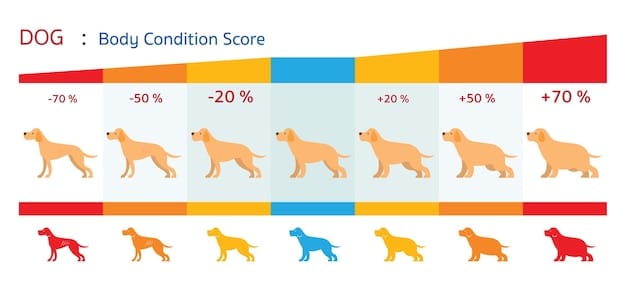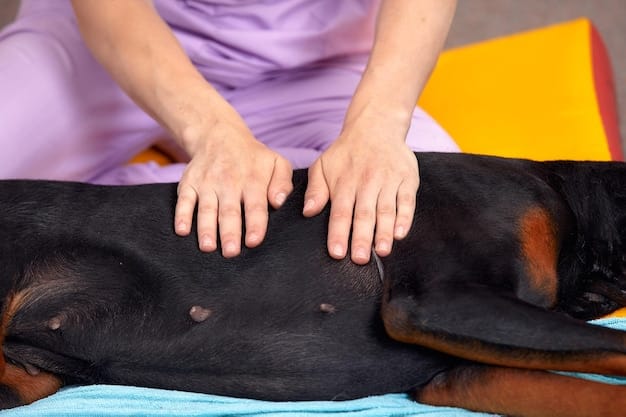Is Your Pet Overweight? Calculate Their Body Condition Score

Anúncios
Determining if your pet is overweight involves calculating their body condition score (BCS), a practical method to assess their fat reserves, helping prevent obesity-related health problems and promote a healthier lifestyle.
Worried about your pet’s weight? It’s a common concern for many pet owners. Learn how to assess their body condition score and prevent future health issues like diabetes and joint problems.Let’s dive into how to determine if your pet is overweight and calculate their ideal body condition score.
Anúncios
Understanding Pet Obesity: A Growing Concern
Pet obesity isn’t just a cosmetic issue; it’s a serious health problem that can significantly impact your pet’s quality of life and lifespan. Just like in humans, excess weight in pets can lead to a host of health complications, making it crucial to recognize and address the issue early.
But how do you know if your furry friend is carrying extra pounds? While visual assessment can be helpful, it’s not always reliable. That’s where the Body Condition Score (BCS) comes in. The BCS is a standardized system used by veterinarians to evaluate a pet’s body fat levels, providing a more objective measure of their weight.
Anúncios
Why is Pet Obesity a Problem?
Obesity in pets can trigger or worsen several health conditions. Here are some of the most common:
- Diabetes: Overweight pets are at a higher risk of developing diabetes, which requires lifelong management with insulin injections and dietary changes.
- Joint Problems: Excess weight puts extra stress on joints, leading to arthritis and decreased mobility.
- Heart Disease: Obesity can strain the cardiovascular system, increasing the risk of heart disease.
- Respiratory Issues: Overweight pets may struggle with breathing, especially during exercise or hot weather.
Recognizing the signs of pet obesity and taking proactive steps can significantly improve your pet’s health and well-being. The Body Condition Score is a valuable tool in this process.
What is the Body Condition Score (BCS)?
The Body Condition Score (BCS) is a widely used method to assess whether your pet is at a healthy weight. It’s a subjective assessment of body fat based on visual and tactile examination of your pet.
Unlike simply weighing your pet, the BCS takes into account their overall body composition and muscle mass. It helps determine if your pet is underweight, ideal weight, overweight, or obese. Different scoring systems exist, but the most common are the 5-point and 9-point scales.

Understanding the 5-Point BCS Scale
In the 5-point scale, a score of 3 indicates an ideal body condition. Scores below 3 suggest underweight, while scores above 3 indicate overweight or obesity.
- 1 – Emaciated: Ribs, spine, and hip bones are easily visible and palpable with no fat covering. Obvious loss of muscle mass.
- 2 – Underweight: Ribs, spine, and hip bones are easily palpable with minimal fat covering.
- 3 – Ideal: Ribs are easily palpable with a slight fat covering. Abdomen is tucked up when viewed from the side. Waist is easily noted when viewed from above.
- 4 – Overweight: Ribs are palpable with a moderate layer of fat. Abdomen is slightly rounded. Waist is not easily noted.
- 5 – Obese: Ribs are difficult to palpate under a thick layer of fat. Significant fat deposits over the spine and base of the tail. Abdomen is obviously rounded with no waist.
The 5-point scale provides a quick and easy way to assess your pet’s body condition. However, it may not be as precise as the 9-point scale.
Using the 9-Point BCS Scale for Accurate Assessment
The 9-point BCS scale offers a more detailed assessment of your pet’s body condition. It provides a wider range of scores, allowing for a more nuanced evaluation of their weight.
In the 9-point scale, a score of 4 or 5 indicates an ideal body condition. Scores below 4 suggest underweight, while scores above 5 indicate overweight or obesity. This scale is often preferred by veterinarians for its greater precision.
Breaking Down the 9-Point Scale
Here’s a detailed look at each score in the 9-point BCS scale:
- 1 – Emaciated: Ribs, spine, and hip bones are prominently visible. No discernible body fat. Severe muscle loss.
- 2 – Very Thin: Ribs, spine, and hip bones are easily visible. Minimal body fat. Some muscle loss.
- 3 – Thin: Ribs are easily palpable and may be visible with no palpable fat. Hip bones easily palpable.
- 4 – Underweight: Ribs are easily palpable with minimal fat covering. Abdomen tucked up. Waist easily noted.
- 5 – Ideal: Ribs are palpable with a slight fat covering. Abdomen tucked up. Waist easily noted.
- 6 – Overweight: Ribs are palpable with a moderate fat covering. Waist is discernible but not prominent.
- 7 – Overweight: Ribs are palpable with a thick fat covering. Fat deposits over the lumbar area. Waist is barely visible.
- 8 – Obese: Ribs are difficult to palpate under a thick layer of fat. Significant fat deposits over the lumbar area and base of the tail. No waist.
- 9 – Severely Obese: Ribs are not palpable under a very thick layer of fat. Massive fat deposits over the body. Distended abdomen.
The 9-point scale provides a more comprehensive assessment, making it easier to identify subtle changes in your pet’s body condition. Regular monitoring using this scale can help you make timely adjustments to their diet and exercise routine.
How to Assess Your Pet’s Body Condition
Assessing your pet’s body condition involves both visual inspection and tactile examination. You’ll need to look at your pet from different angles and feel their ribs, spine, and abdomen.
Start by standing over your pet and looking down at their body shape. Then, view them from the side to assess their abdominal tuck. Finally, use your hands to feel their ribs and spine.

Step-by-Step Guide to Assessing BCS
Follow these steps to accurately assess your pet’s Body Condition Score:
Visual Inspection:
- Overhead View: Look at your pet from above. You should be able to see a slight waistline behind the ribs. If their body is straight or bulging outwards, they may be overweight.
- Side View: Look at your pet from the side. Their abdomen should tuck up behind the ribs. If their abdomen is level with or sagging below the ribs, they may be overweight.
Tactile Examination:
- Rib Palpation: Gently run your hands along your pet’s ribcage. You should be able to feel the ribs with a slight fat covering. If you have to press hard to feel the ribs, they are likely overweight. If the ribs are easily felt with no fat covering, they may be underweight.
- Spine and Hip Bones: Feel along your pet’s spine and hip bones. These should be palpable but not prominently visible. Excessive fat covering in these areas indicates overweight.
It’s important to remember that the ideal BCS can vary slightly depending on your pet’s breed and overall health. Consult with your veterinarian for personalized guidance.
Taking Action: Addressing Weight Issues
Once you’ve assessed your pet’s Body Condition Score, it’s time to take action based on the results. Whether your pet is underweight, overweight, or at an ideal weight, ongoing monitoring and adjustments are key to maintaining their health.
If your pet is underweight, consult with your veterinarian to rule out any underlying health issues and develop a plan to safely increase their weight. If your pet is overweight or obese, it’s crucial to implement a weight loss program under veterinary guidance.
Strategies for Weight Management
Here are some effective strategies for managing your pet’s weight:
- Dietary Changes: Switch to a high-quality, vet-recommended food formulated for weight management. Measure portions carefully to avoid overfeeding.
- Regular Exercise: Increase your pet’s physical activity with daily walks, play sessions, and interactive toys.
- Limit Treats: Reduce the number of treats you give your pet and opt for healthy alternatives like small pieces of vegetables.
Consistency is key to successful weight management. Work closely with your veterinarian to monitor your pet’s progress and make adjustments as needed. They can provide valuable advice and support throughout the process.
Preventing Future Health Problems Through BCS
Regularly monitoring your pet’s Body Condition Score is a proactive way to prevent future health problems associated with weight issues. By identifying weight changes early, you can take steps to adjust their diet and exercise routine, avoiding more serious health complications down the line.
Moreover, staying on top of annual vet checkups and asking for advice on diet and lifestyle choices will help keep your pets healthy.
- Annual Check-Ups: Regular veterinary check-ups are essential for monitoring your pet’s overall health and detecting any potential health problems early. The vet can assess the BCS and make recommendations.
- Personalized Guidance: Work with your veterinarian to develop a personalized plan for your pet’s diet and exercise. This plan should take into account their breed, age, activity level, and any existing health conditions.
- Awareness and Education: Stay informed about the latest research and recommendations for pet nutrition and weight management. The more you know, the better equipped you’ll be to make informed decisions about your pet’s health.
By making Body Condition Scoring a regular part of your pet care routine, you’re investing in their long-term health and well-being. Preventing weight-related health problems can help your pet live a happier, healthier life.
| Key Point | Brief Description |
|---|---|
| 🐶 Body Condition Score | A method to assess body fat levels in pets. |
| 🩺 Health Problems | Obesity can lead to diabetes, joint issues, and heart disease. |
| ⚖️ Weight Management | Diet changes, exercise, and limited treats are important. |
| 🐾 Regular Check-ups | Annual vet visits help monitor overall pet health. |
Frequently Asked Questions
▼
The ideal body condition score typically falls between 4 and 5 on a 9-point scale and 3 on a 5-point scale, indicating a healthy balance of muscle and fat with palpable ribs.
▼
Checking your pet’s body condition score monthly can help you identify any weight changes early on, allowing you to adjust their diet and exercise accordingly for ideal health.
▼
Yes, your vet can provide an accurate assessment of your pet’s body condition during regular check-ups, offering guidance on diet, exercise, and overall health management strategies.
▼
Healthy treat options for pets include small pieces of carrots, cucumbers, or cooked sweet potatoes, ensuring they are given in moderation to maintain a balanced diet.
▼
Regular exercise helps overweight pets burn calories, build muscle, and improve cardiovascular health, aiding in weight loss and overall fitness when combined with a proper diet.
Conclusion
Monitoring your pet’s Body Condition Score (BCS) is essential for the long-term health. Evaluating the BCS and making necessary adjustments to diet and exercise routine, you can ensure your furry friend lives a balanced, energetic life by your side for years to come.






